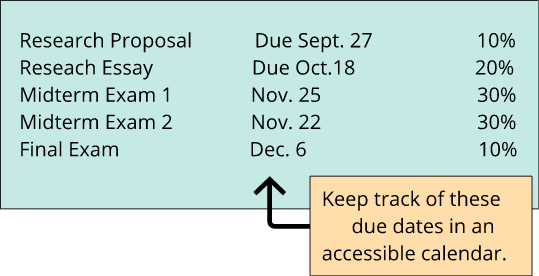8 Understand Your Course Outline
A Course Outline is prepared by your instructor and is like a roadmap for your learning journey. When the course starts, look on Brightspace (NSCC Office 365 login required) for your course outline. Sometimes, instructors will email it or share it in-person.
Parts of a Course Outline
Course Description
The course outline will give you a general overview of what you’ll be doing in the course, plus anything else the instructor would like you to know about the overall plan for the course.
Instructor Contact Information
Your instructor will provide their contact information so you know how to reach them when you need to ask questions, meet with them, or share information with them. It should include their name, email, phone number, classroom, office hour times, and office location.
Course Materials
This will include required and additional materials. These might be textbooks, library materials used in the course, or other items such as safety gear.
You’ll need all these items. Get them from the indicated sources. To start your semester off in the best way possible, you’ll want to purchase required textbooks before the first day of class. You can buy them online through the NSCC Bookstore or in-person at your Campus Bookstore.
Tentative Schedule of Topics, Classes, and Assignments (may change)
This information, such as class times, due dates, external activities, etc., should go into your scheduling device (planner, calendar, online schedule, etc.). In the next chapter, you’ll learn strategies to create a semester and weekly schedule based on the information in your course outline.
Assignments
Assignment topics and due dates are scheduled in advance so you can plan your work, research, and study.
Your course outline may also include some guidelines that indicate what’s required for each assignment, and how the assignments will be graded. Rubrics and checklists must be referenced for projects to ensure that you meet the specified criteria.
Tests and Exams
Put test dates into your calendar as soon as you receive them. You’ll use this information to plan your study times so you’re well prepared for any tests, and can avoid cramming at the last minute.

Policies
It’s important for you to be aware of policies regarding class conduct, evaluation, testing, late assignments, and plagiarism. Make sure you understand the policies that are mentioned in your course outline.
- NSCC Policies and Procedures can be read or downloaded on CONNECT.
(NSCC Office 365 login required.)
By getting to know your course outline, you’ll prepare yourself to meet the expectations of the semester ahead.
Try it!
Find a course outline for 1 of your classes.
You can find course outlines on Brightspace by logging in with your student number and password.
Try to find the following information:
- What textbook(s) or course material(s) you’ll need for class.
- What assignments you’ll need to complete and what will be required.
- When your tests are scheduled.
If you have questions about what you read, contact your instructor.
A guide listing specific criteria for grading or scoring academic papers, projects, or tests. [1]


Feedback/Errata